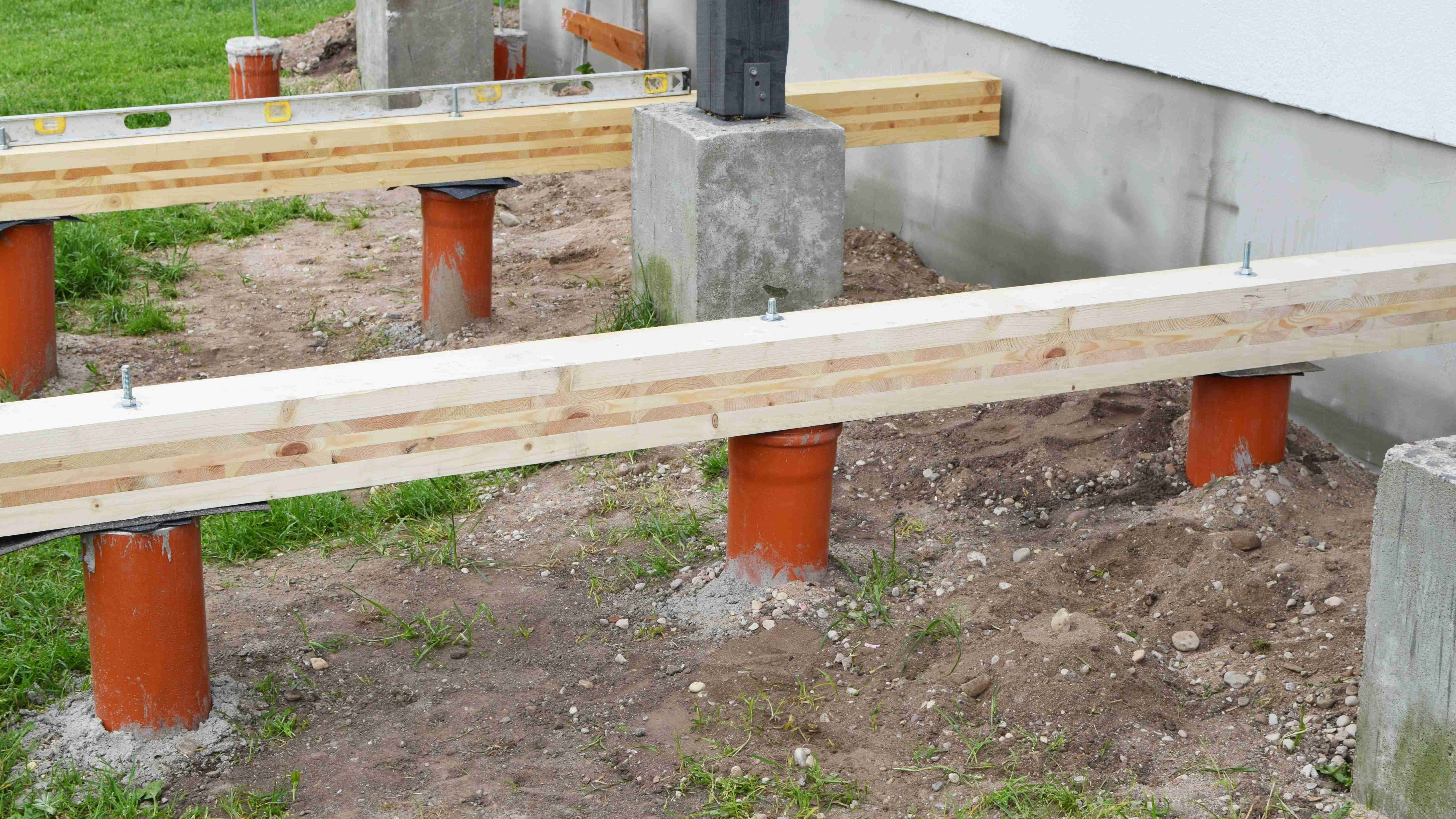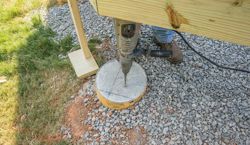Picking the Right Deck Footings for Security and Longevity
The long life and safety and security of your deck depend greatly on the type of grounds you choose, as they give the essential support and stability to endure the examination of time. In this discussion, we will certainly discover the different types of deck grounds, consider the vital elements to consider when making a choice, and dig right into the pros and cons of various options.
Sorts Of Deck Footings
There are numerous kinds of deck footings that can be made use of, each offering special advantages and considerations. One typical sort of ground is the concrete pier footing. These grounds include a round opening loaded with concrete, which supplies a solid structure for the deck posts. Concrete pier footings are reasonably simple to mount and provide outstanding security, making them a preferred choice for several deck tasks.
An additional kind of footing is the helical heap ground. Helical piles are steel shafts with helical plates affixed to them. These footings are installed by screwing them right into the ground, which creates a safe and secure foundation for the deck. Helical pile footings are excellent for locations with tough dirt problems, as they can be installed in virtually any type of soil. They also enable very easy change and leveling of the deck if required.
Alternatively, some builders opt for precast concrete grounds. These grounds are made of durable concrete and can be found in numerous sizes and shapes to accommodate various deck designs. Precast concrete footings are convenient to set up and offer a secure base for the deck framework.
Finally, one more alternative is the post-in-anchor ground system. This sort of ground includes driving a metal support right into the ground and attaching it to the deck blog post. It offers versatility in regards to positioning the deck messages and is suitable for decks with light-weight frameworks.
When choosing the appropriate kind of deck ground, it is vital to think about variables such as soil conditions, deck tons, and local structure codes (Deck Footings). Consulting with a professional contractor or architectural designer can aid ensure the ideal ground is chosen for a risk-free and steady deck
Elements to Think About When Picking Footings
When selecting the appropriate footings for a deck, it is crucial to meticulously consider numerous aspects such as dirt problems, deck lots, and adherence to local building codes. These factors play a considerable duty in ensuring the stability and resilience of the deck structure.
Among the main factors to consider is the dirt problems. The kind of soil on which the deck will be constructed determines the sort of footings called for. As an example, decks built on sandy or loose soils may call for much deeper footings to provide appropriate assistance and stop settling. On the other hand, decks improved clay or expansive dirts might call for grounds that can accommodate the soil's tendency to broaden and contract.
An additional important variable is the deck load. The weight of the deck, including the materials utilized and any kind of potential live lots such as furniture or celebrations, have to be thought about when choosing footings. The footings must be designed to birth the weight of the deck and distribute it evenly to avoid any architectural problems or failings.
Finally, adherence to neighborhood structure codes is vital. Building codes differ from area to area, and it is necessary to abide by the details needs set by the local authorities. Deck Footings. These codes guarantee that the deck is constructed securely and meets the needed requirements for architectural stability and load-bearing capability
Concrete Grounds: Pros and Disadvantages

Concrete footings provide several advantages and negative aspects when used as the foundation for a deck. On the positive side, concrete grounds supply excellent security and resilience. Concrete is a solid and rigid material that can support hefty lots and withstand numerous climate condition. It additionally has a lengthy life-span, making it a dependable option for long-term usage.
One more benefit of concrete grounds is their adaptability. They can be poured right into various sizes and shapes to suit various deck designs and configurations. Concrete footings can be customized to fit the specific demands and demands of the deck framework.
Nevertheless, there are likewise some drawbacks to using concrete grounds. One significant disadvantage is the cost and labor entailed in their installment. Concrete grounds need excavation and typically require the help of heavy machinery. This can raise the total expense of the deck project and may require specialist help.

Helical Piers Vs. Sonotubes: Which Is Much better?
In thinking about the structure alternatives for a deck, the comparison between helical piers and sonotubes is essential in establishing the superior choice. Helical piers, also Bonuses known as screw piles, are steel shafts with helical plates attached to them. They are twisted into the ground using hydraulic machinery, providing a sturdy and secure structure for the deck. On the various other hand, sonotubes are round types made from cardboard or fiber product that are loaded with concrete. They are put in a hole went into the ground and offer support for the deck.
The helical plates on the piers develop a strong grasp with the soil, avoiding any kind of movement or moving of the deck. Sonotubes, on the other hand, count exclusively on the concrete filling for security, which might not use the very same level of toughness and resistance.
In terms of setup, helical piers are webpage relatively much easier and faster to set up contrasted to sonotubes. The hydraulic machinery made use of to turn the piers into the ground makes certain a quick and effective procedure. Sonotubes, on the various other hand, need excavating openings and pouring concrete, which can be taxing and labor-intensive.
In addition, helical piers are an even more versatile choice. They can be made use of in various soil conditions and can be adjusted or strengthened if needed. Sonotubes, on the various other hand, might require extra assistance, such as rebar, in particular dirt conditions or areas with high lots requirements.
Selecting the Right Footings for Your Deck's Dimensions
For ideal architectural honesty, it is vital to very carefully pick the appropriate footings that align with the dimensions of your deck. The dimensions of your deck, including its length, elevation, and width, play a substantial function in figuring out the kind and size of footings needed.
When choosing grounds for your deck, it is essential to consider the load-bearing ability of the dirt. The weight of the deck, incorporated with the weight of any kind of furnishings or individuals on it, applies a substantial pressure on the grounds (Deck Footings). It is crucial to pick footings that can adequately sustain this weight without shifting or sinking over time.
Bigger decks with higher dimensions need larger grounds to offer enough stability and assistance. The shape of the grounds, whether they are square or rounded, depends on the style and format of the deck.
Final Thought
In conclusion, selecting the right deck grounds is important for ensuring security and sturdiness. this hyperlink Factors such as the kind of grounds, the deck's dimensions, and the pros and disadvantages of different choices should be thought about. Concrete grounds provide stamina and longevity, but may be a lot more expensive and lengthy to set up. Helical piers and sonotubes have their own benefits and negative aspects. Ultimately, picking the appropriate grounds for your deck's particular needs is important for a lasting and successful framework.
These grounds are composed of a cylindrical opening loaded with concrete, which provides a solid foundation for the deck posts. Concrete pier footings are relatively simple to install and provide exceptional security, making them a prominent selection for several deck projects.
Precast concrete footings are convenient to install and offer a stable base for the deck structure.
It offers adaptability in terms of positioning the deck articles and is suitable for decks with light-weight structures.
Concrete footings provide a number of advantages and downsides when utilized as the structure for a deck.